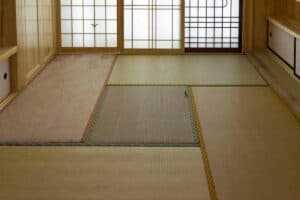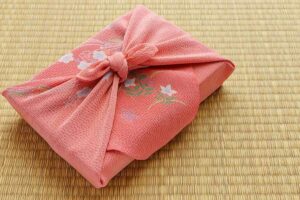Japan boasts a rich cultural heritage and many beautiful attractions, making it a world-famous tourist destination.
If you have ever visited the Land of the Rising Sun, you probably have encountered Kotatsu Tables.
Nothing beats the warmth afforded by these tables in winters which can get particularly extreme in Japan.
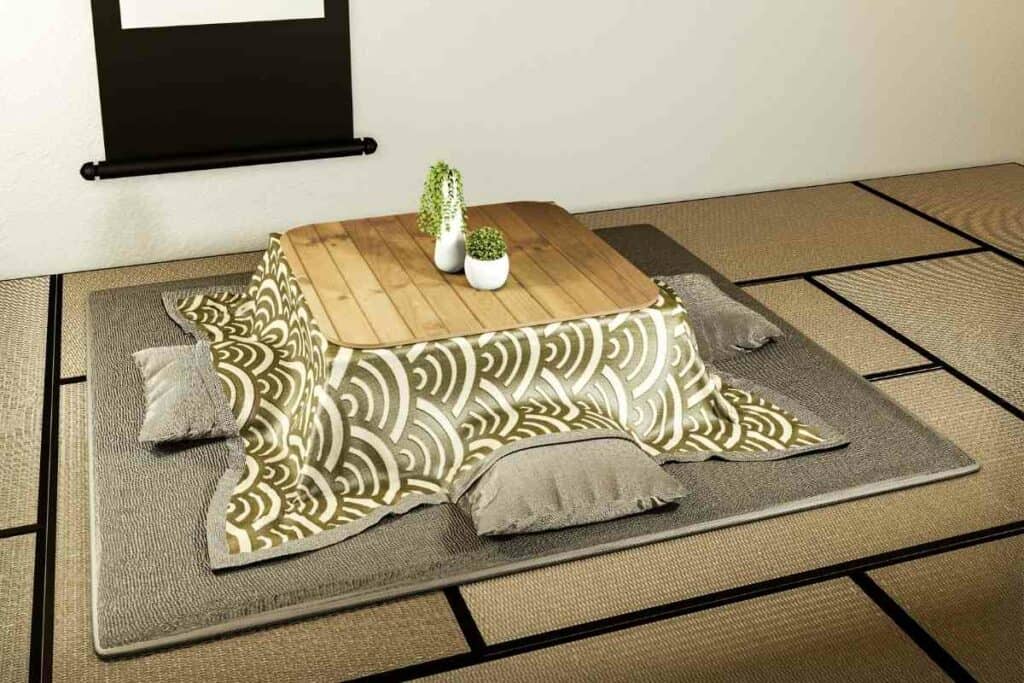
A Kotatsu is a low-lying wooden table covered by a heavy blanket called a futon.
In the past, these tables were fixed at the center of the living room, with heat generated from an in-ground firepit. Nowadays, they’re portable.
The common denominator is that Kotatsu tables are a standard fixture in Japanese homes, both ancient and present.
Most Japanese homes don’t have central heating, despite the frequency of cold winters in the country.
Instead, locals rely on Kotatsu tables to keep warm. These are classier and more cost-effective alternatives to AC units.
Table of Contents
The History of Kotatsu
Kotatsu tables became popular between the 14th and 16th centuries, during the Muromachi era.
Homeowners placed a platform on the Fireplaces (called ‘irori’) and covered it with heavy clothing to preserve heat.
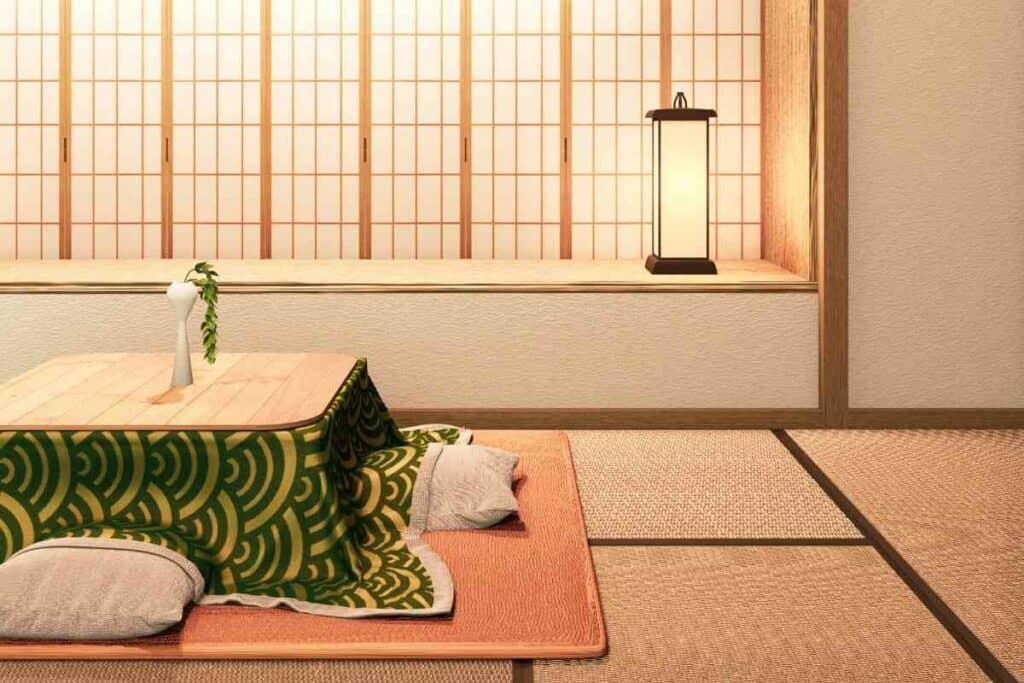
In the Edo period (1603-1868), new forms of the Kotatsu (Oki-gotatsu) emerged. The new tables substituted the fireplace for a brazier known as ‘hibachi.’
The separation from the ‘irori’ made the table movable, increasing its popularity. The first tables relied on charcoal burning to produce heat.
Electric models became available in the Taisho period (the early 1900s) and gained mainstream popularity after the Second World War.
Modern Kotatsu Tables
Modern Kotatsu tables use electricity to power an attached infrared heater.
When emitted, heat gets trapped between the blanket and the rug.
This design allows you to warm yourself by covering your legs with the blanket while using the tabletop like a regular table.
Additionally, modern Kotatsu tables are portable.
As a Result – Most homeowners place these tables in rooms with high activity during winter. Family members gather around the tables to tell stories, watch TV, play games, and do other pastime activities.
Types of Kotatsu Tables and Futons
Kotatsu tables are available in many styles and designs.
You can choose basic shapes like round, square, and rectangle or request a custom one.
Although Kotatsu tables are mostly low, you can purchase a higher unit if you find it challenging to sit in the traditional Japanese style.
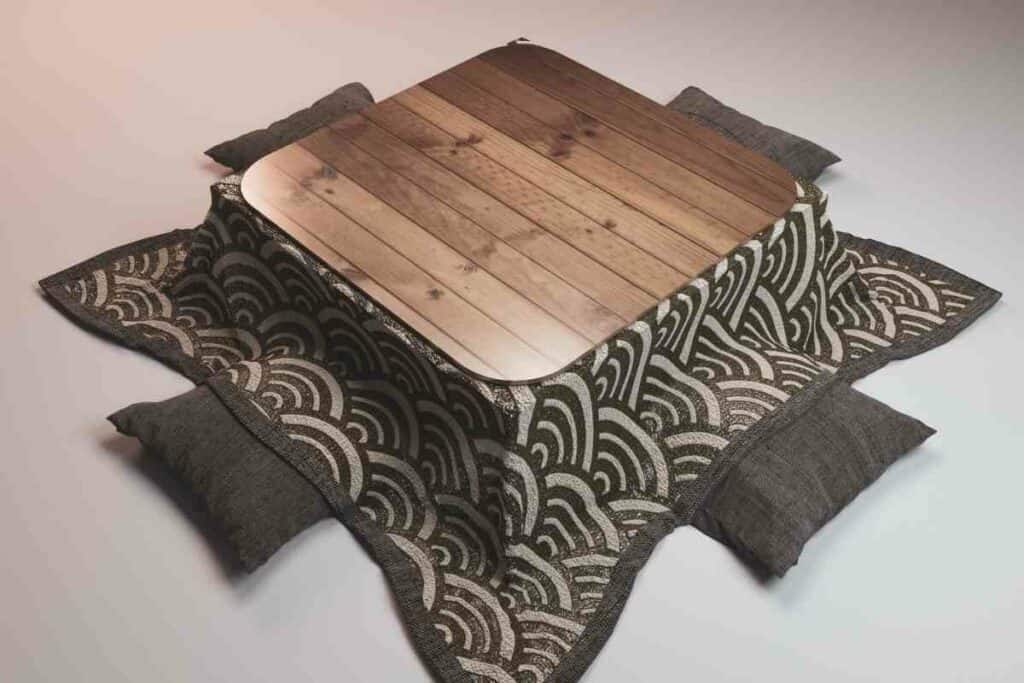
The best way to increase the height of a Kotatsu table is to use a furniture riser. These risers are available in local furniture stores and online marketplaces.
Another exciting aspect of modern Kotatsu tables is the legs. Some have fixed legs, while others are foldable.
The latter offers more flexibility, allowing you to raise or lower the tabletop, and move the table more conveniently.
Futons come in many shapes and sizes. You can also choose your preferred thickness. While a thicker blanket is cozier and warmer, it takes up more floor space.
If you want to use space optimally, consider purchasing a space-saving futon called the ‘sho-supesu futon.’ It has cut corners such that it takes up less space.
Types of Kotatsu Heaters
As mentioned above, modern Kotatsu tables use electric heaters that are more effective than charcoal used on old models.
Infrared heaters are the most popular, followed by halogen, flat carbon, and quartz heaters.
Halogen heaters are ideal if you want to warm your home fast. Moreover, halogen tubes have a relatively long lifespan, lasting more than 8,000 hours.
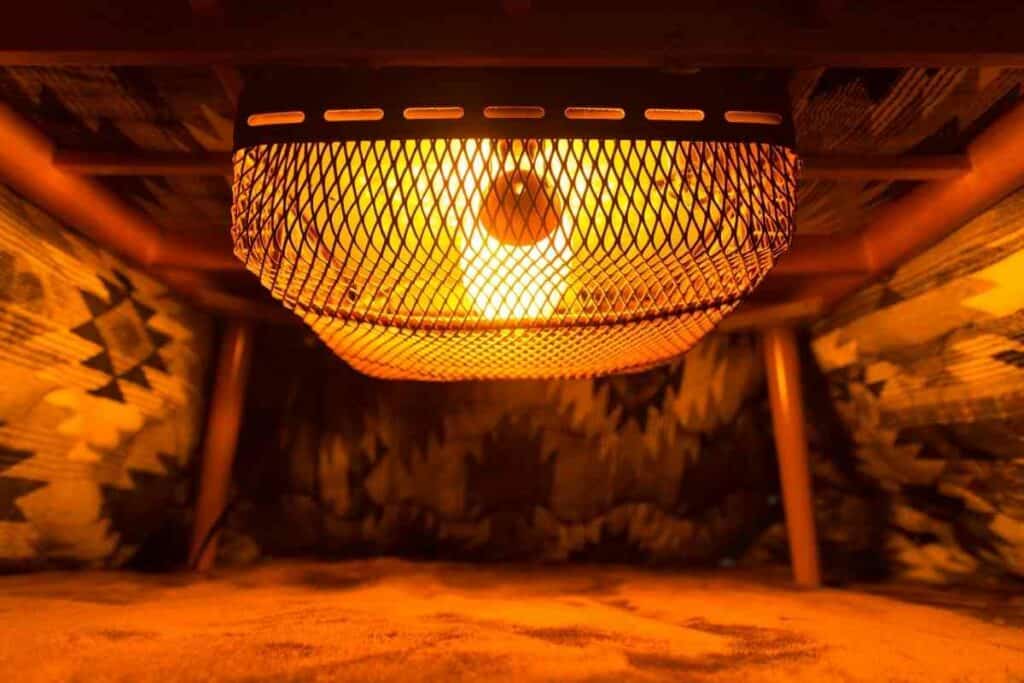
However, the increased efficiency translates into higher electric bills.
Flat carbon heaters are excellent at heating large spaces but slow. Quartz is also slow, although it consumes little electricity.
The best electric heater type for your Kotatsu table depends on your preferences.
Additional Features of Kotatsu Tables
Modern Kotatsu tables have several fancy features, including:
- Electronic Temperature Control: modern tables have thermistors instead of thermostats, allowing you to fine-tune the heating level depending on the ambient temperature.
- Inbuilt Timer: this allows you to configure the time you want the heater to run. Besides saving energy, it improves safety in case you sleep while keeping warm.
- Motion Sensor: this detects activity around the heating element. If nobody is around, the heater goes off automatically.
What Makes Kotatsu Tables Special?
If you’re a first-time visitor to Japan, you will discover that winters get too cold.
Except for Hokkaido, most homes don’t have a central heating system, which is surprising for such a developed economy.
Nevertheless, the theme cuts across, regardless of the neighborhood.
The primary reason Japanese homes are too cold in winter is their design.
Japanese architecture emphasizes making interior spaces comfortable during the hot and humid summers.
The country experiences scorching hot conditions from June to September, often preceded by Tsuyu – the rainy season.
Secondly – Most of the country experiences short and mild winters. Only the Northern parts feel the cold. It’s why many homes don’t have heating systems.
Japanese people treasure Kotatsu tables because they provide ambiance, coziness, and warmth at a fraction of the cost of running air conditioning systems.
Moreover, these tables are integral to the country’s rich cultural heritage.
Advantages of a Kotatsu Table
With many heating options to choose from, why should you go for Kotatsu tables?
Read on to discover.
- Better air quality: heaters that run on fossil fuels produce harmful gases such as carbon dioxide, nitrous oxide, and carbon monoxide. With Kotatsu, such emissions aren’t a problem.
- Ease of use: you can keep warm by turning on a switch. Unlike wood-fired heaters and traditional fireplaces, you don’t have to add fuel regularly.
- Energy-efficient: a typical Kotatsu table consumes 500W at its peak. When on standby mode, it consumes as little as 80W. This is lower than its competition, which consumes as much as 2,400W. Besides lower bills, Kotatsu tables are eco-friendly.
- Versatility: when idle, you can use the Kotatsu table as a regular table. All you need is to remove the futon, and you’re set!
How to Build a Kotatsu Table
You don’t have to visit Japan to get the Kotatsu experience.
You can make the table yourself with a little resourcefulness and a few bucks.
Here’s how to go about it.
Requirements
Here’s what you’ll need to build your Kotatsu table.
Coffee Table
Find a coffee table with two tabletops. Ensure it’s neither too large nor too tiny to fit your space.
The last thing you want is a table that looks out of place.
If you can’t find a table with two tops, purchase two regular tables instead.
Table Heating Element
Kotatsu-specific heating elements are available on leading online marketplaces like Amazon and eBay.
When shopping, please avoid cheap options because they aren’t reliable.
Also, don’t purchase space heaters. Although they’re cheaper, space heaters are risky.
High-quality Blanket or Comforter
You don’t have to purchase a new blanket to use as a futon. Old comforters can do the job.
A 500W Voltage Transformer
The transformer steps down the voltage from the 120 volts used on American appliances to 100 volts used on Japanese electrical equipment.
If you don’t have a transformer, the heating element overheats and can get damaged.
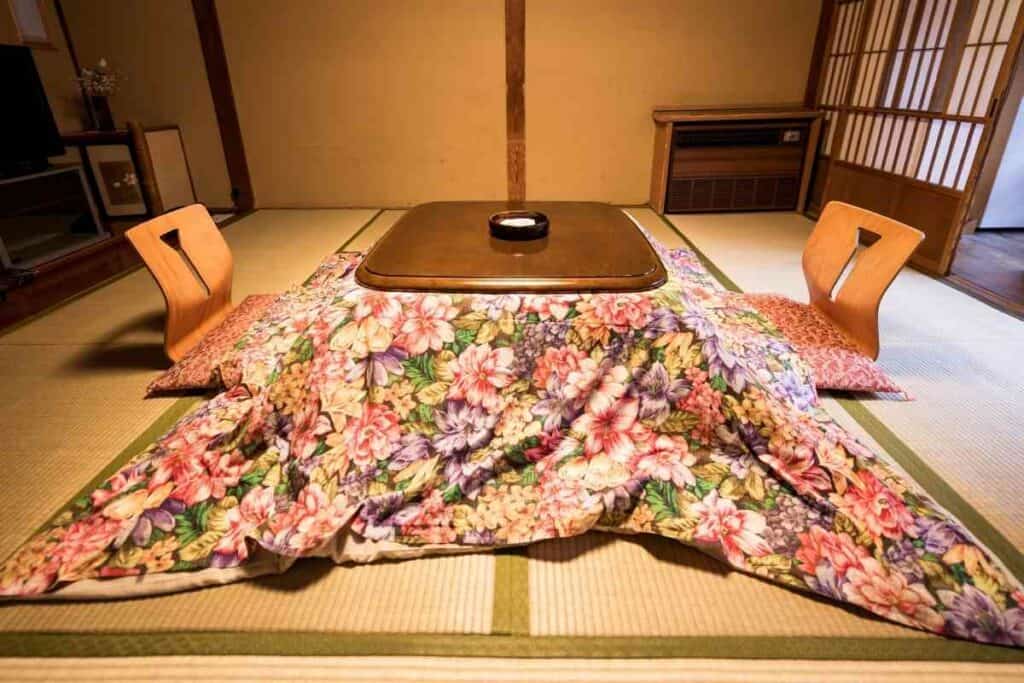
The materials mentioned above are the bare minimum.
For an optimal experience, consider getting the following optional items.
- Pillows: these add more comfort than sitting on the floor.
- Floor chair: chairs are an alternative to pillows.
Procedure
Once you have the requirements, making a Kotatsu table is easy. The process usually takes a few hours.
Here’s how to do it.
Mount the Heater
Mount the heating element on the underside of your coffee table. Ensure that it’s steady, and use braces for extra support if needed.
Turn on the Heater
After mounting the heater, please switch it on and adjust the temperature to the desired level.
Try sitting around the table to see if it’s comfortable. If not, use risers to raise it to a comfortable height.
Frequently Asked Questions
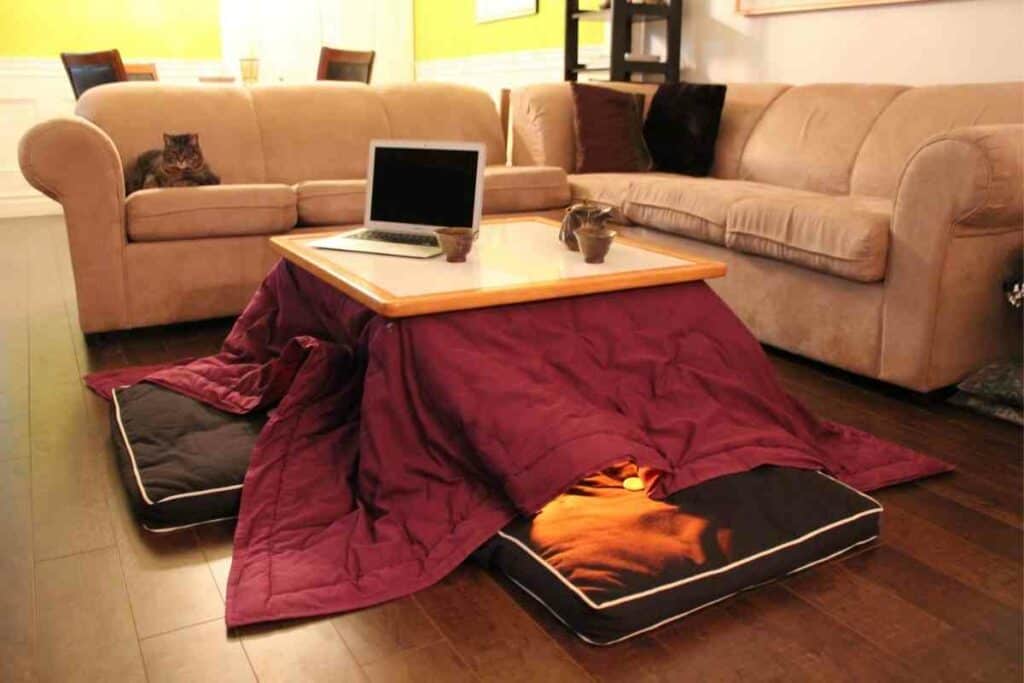
Can You Sleep under a Kotatsu Table?
Kotatsu tables offer conducive conditions for a short nap during winter, but overnight sleeping isn’t recommended.
Continuous exposure to heat increases the risk of dehydration. Also, you might burn yourself when you touch the heating element.
Are Kotatsu Tablets Safe?
The safety of a Kotatsu table depends on your handling. If you keep off the heating element, there isn’t any reason for concerns.
However, overusing the table and improper handling is risky.
Can You Heat Food on a Kotatsu Table?
In Japan, concurrent cooking and eating are common.
As a result, portable induction cookers and tabletop stoves are popular across the country.
However, the Kotatsu table doesn’t support this cultural practice.
So don’t leave your cooking equipment behind if you want to enjoy your meal on a Kotatsu table!
Wrapping Up
The Kotatsu table is another piece of Japanese history that piques great interest.
Despite its simple design, it offers unmatched coziness and warmth in winter at a price much cheaper than other heating options.
What’s more, you don’t have to spend much money to bring this marvel to your home – you can make one yourself!
In Case You Missed It
- Best Japanese Knives Top Picks for Every Kitchen
- Japan’s Bold New Trend: Dressing Like a British Gentleman (or at Least Trying)
- 7 Best Japanese Sunscreen Products You Can Buy Online
- 5 Best Japanese Makeup Brushes for a Flawless Finish
- 7 Benefits Of Tatami Mats You Should Know
- The Best Furoshiki Wrapping Cloths: Inspiration, Ideas & Cloths You Can Buy





